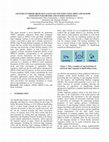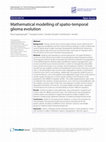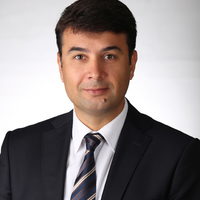Papers by Maria Papadogiorgaki

This paper presents a distributed client-server architecture for the personalized delivery of tex... more This paper presents a distributed client-server architecture for the personalized delivery of textual news content to mobile users. The user profile consists of two separate models, that is, the long-term interests are stored in a skeleton profile on the server and the short-term interests in a detailed profile in the handset. The user profile enables a high-level filtering of available news content on the server, followed by matching of detailed user preferences in the handset. The highest rated items are recommended to the user, by employing an efficient ranking process. The paper focuses on a two-level learning process, which is employed on the client side in order to automatically update both user profile models. It involves the use of machine learning algorithms applied to the implicit and explicit user feedback. The system's learning performance has been systematically evaluated based on data collected from regular system users.
IGI Global eBooks, May 24, 2011
Encyclopedia of information science and technology / Mehdi Khosrow-Pour, editor. --2nd ed. p. cm.... more Encyclopedia of information science and technology / Mehdi Khosrow-Pour, editor. --2nd ed. p. cm. Includes bibliographical references and index. Summary: "This set of books represents a detailed compendium of authoritative, research-based entries that define the contemporary state of knowledge on technology"--Provided by publisher.

Earth Science Informatics, Jul 17, 2017
Several international studies attempt to construct tangible GIS systems, forming real 3D surfaces... more Several international studies attempt to construct tangible GIS systems, forming real 3D surfaces using a large number of mechanical parts along a matrix formation. Most of these attempts suffer in cost, accuracy, resolution and/or speed. In order to facilitate data handling in GIS tangible systems, the generalization process becomes crucial, accommodating compression, visualization and comprehension of spatial data under various scales. Under this perspective, the main objective of the proposed adaptive generalization approach is to provide optimized representation of 3D digital terrain models with minimum loss of information, serving specific applications. That is, to minimize the number of pixels in a raster dataset used to define a DTM, while reserving surface information and enhancing the important semantic features. To this aim, this paper presents specific computationally efficient surface generalization approaches, which can be incorporated in applications of tangible GIS systems, due to their low processing time, facilitating real-time results. The research methods developed and tested include adaptive variations of a) the Douglas-Peucker line simplification algorithm in 3D data and b) the spatial Laplace filter that estimates the significance of each node, based on its nearest neighbors. The proposed strategy also dynamically incorporates topology and semantic restraints, in order to preserve important information and depict it with variable detail level, according to the application at hand. The algorithms are evaluated on their accuracy for a specific wildfire application and for different reduction levels in two different types of terrain data. They are also compared to their original-basic implementations in terms of performance.

Electronics
In this review paper, we look into how a recommendation system can be adapted to and support peop... more In this review paper, we look into how a recommendation system can be adapted to and support people with intellectual disability (ID). We start by reviewing and comparing the main classes of techniques for general-purpose content recommendation. Then, centering on individuals with ID, we collect information on their special needs that may be relevant to or affected by content recommendation tasks. We review the few existing recommendation systems specifically designed or adapted to the needs of this population and finally, based on the reviewed literature sources, we catalog the traits that a future content recommendation system should have in order to respond well to the identified special needs. We hope this listing of desirable traits and future directions in our concluding sections will stimulate research towards opening the doors to the digital world for individuals with ID.
Proceedings of the 15th International Conference on PErvasive Technologies Related to Assistive Environments
People with Intellectual Disability (ID) encounter several problems in their daily living regardi... more People with Intellectual Disability (ID) encounter several problems in their daily living regarding their needs, activities, interrelationships, and communication. On this concept, an interactive platform is proposed, aiming to provide personalized recommendations for information and entertainment, including creative and educational activities, tailored to the special users’ needs of this population. Furthermore, the proposed platform integrates capabilities of automatic recognition of health related emergencies, such as fever, oxygen saturation decline and tachycardia, as well as location tracking and detection of wandering behavior based on smartwatch/smartphone sensors, while providing automated assistance and appropriate alerts and notifications to the caregivers.
2022 IEEE International Conference on Imaging Systems and Techniques (IST)

Proceedings of the 13th ACM International Conference on PErvasive Technologies Related to Assistive Environments
People with intellectual disabilities (ID) encounter several problems regarding the interaction w... more People with intellectual disabilities (ID) encounter several problems regarding the interaction with their environment in terms of their daily needs, activities and communication. On this concept, an interactive support system with multiple functionalities is proposed, aiming at optimizing the opportunities provided to people with ID in order to cope with particular everyday issues. Specifically, it will provide information as well as entertainment, including creative and educational activities, through specialized learning programs. Additionally, it will automatically recognize health emergency situations, provide appropriate notifications, feature an emergency call button to contact the responsible caregivers, and support interaction using a specialized voice menu of instructions. The final system will be developed within a Greek research project and a pilot implementation will be evaluated by a Greek association of people with ID. The ultimate goal is to provide an affordable and user-friendly solution, tailored to the users' needs.

Medical & biological engineering & computing, 2018
Glioma brain tumors exhibit considerably aggressive behavior leading to high mortality rates. Mat... more Glioma brain tumors exhibit considerably aggressive behavior leading to high mortality rates. Mathematical modeling of tumor growth aims to explore the interactions between glioma cells and tissue microenvironment, which affect tumor evolution. Leveraging this concept, we present a three-dimensional model of glioma spatio-temporal evolution based on existing continuum approaches, yet incorporating novel factors of the phenomenon. The proposed model involves the interactions between different tumor cell phenotypes and their microenvironment, investigating how tumor growth is affected by complex biological exchanges. It focuses on the separate and combined effect of vital nutrients and cellular wastes on tumor expansion, leading to the formation of cell populations with different metabolic, proliferative, and diffusive profiles. Several simulations were performed on a virtual and a real glioma, using combinations of proliferation and diffusion rates for different evolution times. The ...

Earth Science Informatics, 2017
Several international studies attempt to construct tangible GIS systems, forming real 3D surfaces... more Several international studies attempt to construct tangible GIS systems, forming real 3D surfaces using a large number of mechanical parts along a matrix formation. Most of these attempts suffer in cost, accuracy, resolution and/or speed. In order to facilitate data handling in GIS tangible systems, the generalization process becomes crucial, accommodating compression, visualization and comprehension of spatial data under various scales. Under this perspective, the main objective of the proposed adaptive generalization approach is to provide optimized representation of 3D digital terrain models with minimum loss of information, serving specific applications. That is, to minimize the number of pixels in a raster dataset used to define a DTM, while reserving surface information and enhancing the important semantic features. To this aim, this paper presents specific computationally efficient surface generalization approaches, which can be incorporated in applications of tangible GIS systems, due to their low processing time, facilitating real-time results. The research methods developed and tested include adaptive variations of a) the Douglas-Peucker line simplification algorithm in 3D data and b) the spatial Laplace filter that estimates the significance of each node, based on its nearest neighbors. The proposed strategy also dynamically incorporates topology and semantic restraints, in order to preserve important information and depict it with variable detail level, according to the application at hand. The algorithms are evaluated on their accuracy for a specific wildfire application and for different reduction levels in two different types of terrain data. They are also compared to their original-basic implementations in terms of performance.

2nd IET International Conference on Intelligent Environments (IE 06), 2006
This paper presents a novel approach for generating VRML animation sequences from Sign Language n... more This paper presents a novel approach for generating VRML animation sequences from Sign Language notation, based on MPEG-4 Face and Body Animation. Sign Language notation, in the well-known SignWriting system, is provided as input and is initially converted to SWML (Sign Writing Markup Language), an XML-based format that has recently been developed for the storage, indexing and processing of Sign Writing notation. Each basic sign, namely signbox, is then converted to a sequence of Body Animation Parameters (BAPs) of the MPEG-4 standard, corresponding to the represented gesture. Inverse Kinematics are also employed for synthesizing complex animation sequences (e.g. contacts). In addition, if a sign contains facial expressions, these are converted to a sequence of MPEG-4 Facial Animation Parameters (FAPs), while exact synchronization between facial and body movements is guaranteed. These sequences, which can also be coded and/or reproduced by MPEG-4 BAP and FAP players, are then used to animate H-anim compliant VRML avatars, reproducing the exact gestures represented in the sign language notation. Envisaged applications include interactive information systems for the persons with hearing disabilities (Web, Email, info-kiosks) and automatic translation of written texts to sign language (e.g. for TV newscasts).
International Journal on Disability and Human Development, 2005
... Thumb Outter Joint Thumb Outter Joint Index Outter Joint Index Outter Joint Middle Finger Out... more ... Thumb Outter Joint Thumb Outter Joint Index Outter Joint Index Outter Joint Middle Finger Outter Joint Middle Finger Outter Joint Ring Outter Joint Ring Outter Joint Pinky Outter Joint Pinky Outter Joint Fig. ... In vector notation, this can be expressed as s=s(θ), where s kj ≤ ≤ 1 ...

IEEE Journal of Biomedical and Health Informatics, 2014
Cancer-tumor growth is a complex process depending on several biological factors, such as the che... more Cancer-tumor growth is a complex process depending on several biological factors, such as the chemical microenvironment of the tumor, the cellular metabolic profile and its proliferation rate. Several mathematical models have been developed for identifying the interactions between tumor cells and tissue microenvironment, since they play an important role in tumor formation and progression. Towards this direction we propose a new continuum model of avascular glioma-tumor growth, which incorporates a new factor, namely the glycolytic potential of cancer cells, to express the interactions of three different tumor-cell populations (proliferative, hypoxic and necrotic) with their tissue microenvironment. The glycolytic potential engages three vital nutrients, i.e. oxygen, glucose and lactate, which provide cells with the necessary energy for their survival and proliferation. Extensive simulations are performed for different evolution times and various proliferation rates, in order to investigate how the tumor growth is affected. According to medical experts, the experimental observations indicate that the model predicts quite satisfactorily the overall tumor growth as well as the expansion of each region separately. Following extensive evaluation, the proposed model may provide an essential tool for patient-specific tumor simulation and reliable prediction of glioma spatio-temporal expansion.

2021 IEEE International Conference on Imaging Systems and Techniques (IST), 2021
The classification of recyclable materials, and in particular the recovery of plastic, plays an i... more The classification of recyclable materials, and in particular the recovery of plastic, plays an important role in the economy, but also in environmental sustainability. This study presents a novel image classification model that can be efficiently used to distinguish recyclable materials. Building on recent work in deep learning and waste classification, we introduce the so-called "Dual-branch Multi-output CNN", a custom convolutional neural network composed of two branches aimed to i) classify recyclables and ii) distinguish the type of plastic. The proposed architecture is composed of two classifiers trained on two different datasets, so as to encode complementary attributes of the recyclable materials. In our work, the Densenet121, ResNet50 and VGG16 architectures were used on the Trashnet dataset, along with data augmentation techniques, as well as on the WaDaBa dataset with physical variation techniques. In particular, our approach makes use of the joint utilization of the datasets, allowing the learning of disjoint label combinations. Our experiments confirm its effectiveness in the classification of waste material.

Full list of author information is available at the end of the article Background: Gliomas are th... more Full list of author information is available at the end of the article Background: Gliomas are the most common types of brain cancer, well known for their aggressive proliferation and the invasive behavior leading to a high mortality rate. Several mathematical models have been developed for identifying the interactions between glioma cells and tissue microenvironment, which play an important role in the mechanism of the tumor formation and progression. Methods: Building and expanding on existing approaches, this paper develops a continuous three-dimensional model of avascular glioma spatio-temporal evolution. The proposed spherical model incorporates the interactions between the populations of four different glioma cell phenotypes (proliferative, hypoxic, hypoglychemic and necrotic) and their tissue microenvironment, in order to investigate how they affect tumor growth and invasion in an isotropic and homogeneous medium. The model includes two key variables involved in the prolifera...
2021 IEEE 21st International Conference on Bioinformatics and Bioengineering (BIBE)

An emerging trend in the biomedical community is to create models that take advantage of the incr... more An emerging trend in the biomedical community is to create models that take advantage of the increasing available computational power, in order to manage and analyze new biological data as well as to model complex biological processes. Such biomedical software applications require significant computational resources since they process and analyze large amounts of data, such as medical image sequences. This paper presents a novel FPGA-based system that implements a novel model for the prediction of the spatio-temporal evolution of glioma. Glioma is a rapidly evolving type of brain cancer, well known for its aggressive and diffusive behavior. The developed system simulates the glioma tumor growth in the brain tissue, which consists of different anatomic structures, by utilizing individual MRI slices. The presented innovative hardware system is more than 60% faster than a high-end server consisting of 20 physical cores (and 40 virtual ones) and more than 28x more energy efficient.









Uploads
Papers by Maria Papadogiorgaki